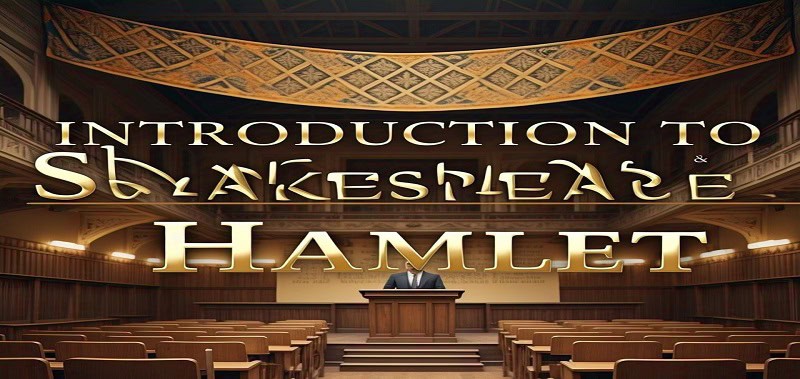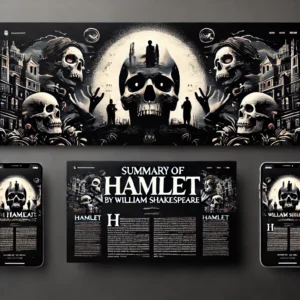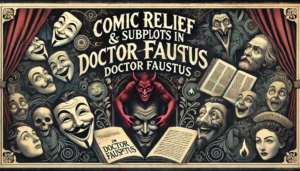Introduction to Hamlet
William Shakespeare is widely regarded as the greatest playwright in English literature, and Hamlet is one of his most celebrated tragedies. Written around 1600–1601, the play reflects the intellectual, political, and philosophical concerns of the Elizabethan era. Understanding the historical and cultural context of Shakespeare’s time helps us appreciate the themes and dramatic techniques in Hamlet. This text gives a comprehensive introduction to Hamlet and Shakespeare to contextualize readers’ understanding.

Elizabethan Theater: The Rise of English Drama
Shakespeare wrote during the Elizabethan era (1558–1603), a period of literary and artistic growth under Queen Elizabeth I. This was a golden age for English drama, marked by the rise of professional theaters, including the famous Globe Theatre, where many of Shakespeare’s plays were performed.
Elizabethan theater had distinct features:
- Open-air playhouses: Theaters like the Globe had no roofs, so performances took place in daylight.
- Minimal scenery: The focus was on language, acting, and costumes rather than elaborate stage designs.
- Male actors only: Women were not allowed to perform, so young boys played female roles, including Ophelia and Gertrude in Hamlet.

Shakespeare’s plays, including Hamlet, used poetic language, soliloquies, and rich symbolism, making them highly engaging for Elizabethan audiences.
Historical & Political Background: The Age of Uncertainty
During Shakespeare’s time, England was undergoing significant political and social changes:
- The Tudor Dynasty & Succession Crisis
Queen Elizabeth I, the last monarch of the Tudor dynasty, ruled without a clear heir. This created uncertainty and fear about the country’s future. Hamlet reflects this concern through its theme of political instability—Denmark’s throne is in crisis after King Hamlet’s mysterious death. - The Protestant Reformation & Religious Conflicts
England had recently broken away from the Catholic Church under Henry VIII, leading to religious tensions. Hamlet explores questions of the afterlife, morality, and divine justice, which were major concerns of the time. - The Renaissance & Humanism
The Renaissance, a cultural revival of classical learning, emphasized individual thought and reason. Hamlet embodies this intellectual spirit—he is a deep thinker who questions life, fate, and existence, as seen in his famous soliloquy:
“To be or not to be, that is the question.” (Act 3, Scene 1)
This reflects the Renaissance emphasis on self-examination and philosophical inquiry.
Shakespeare’s Hamlet: A Reflection of Its Time
Shakespeare’s Hamlet mirrors the political and philosophical anxieties of Elizabethan England. It explores themes of power, revenge, fate, and existential doubt, making it relevant beyond its historical context. Its enduring legacy continues to influence modern literature, film, and theater, proving that Shakespeare’s genius remains timeless.
#introduction to Hamlet #introduction to Hamlet #introduction to Hamlet #introduction to Hamlet #introduction to Hamlet #introduction to Hamlet #introduction to Hamlet #introduction to Hamlet #introduction to Hamlet
Read More
Revenge Tragedy Tradition in Hamlet
Legacy and Themes of Doctor Faustus
Comic Relief & Subplots in Doctor Faustus
The Role of Mephistopheles and the Devil Pact in Dr Faustus
Introduction to Dr Faustus and Marlowe
Classical Theatre and Classical Drama
Plot Construction in Pride and Prejudice
Introduction to Fiction and Non Fiction
Of Death — Francis Bacon (Text)
Of Truth Critical Analysis by Sir Francis Bacon
Of Truth by Francis Bacon Summary
Visit Us on our Facebook Page:






